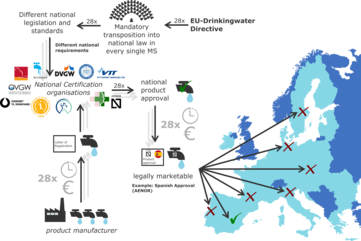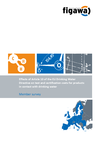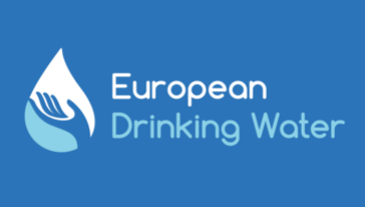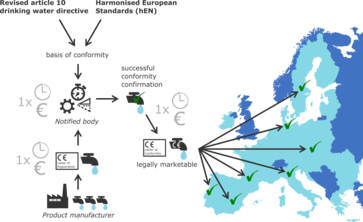Harmonisation of materials and products in contact with drinking water in Europe

The European Drinking Water Directive has been revised in recent years and entered into force on the 12th of January 2021:
Standards for products in contact with drinking water
The European standardisation of products in contact with drinking water has been on the agenda since the 1980s. Today almost all products are already described in common European standards (EN).
However, the important aspect of hygienic suitability for contact with drinking water and the associated requirements are still missing.
A lack of harmonisation is a barrier to the principle of the free movement of goods.
Regulation (EC) No 764/2008 on the free movement of goods states that "a Member State may not prohibit the sale on its territory of products which are lawfully marketed in another Member State, even where those products were manufactured in accordance with technical rules different from those to which domestic products are subject".
Exceptions to this principle are, however, permitted for issues justified on the basis of overriding reasons of public interest. These include the 'protection of human health and life', which provides each European country with a possible justification for maintaining its own requirements for materials and products in contact with drinking water.
Uniform hygienic testing requirements in Europe are now being implemented
With the Drinking Water Directive (DWD), the EU provides the legal framework for the protection of human health. This also applies to materials that come into contact with drinking water.
The new Article 11 of the EU Drinking Water Directive "Minimum hygiene requirements for materials that come into contact with water intended for human consumption" obliges the EU member states to draw up European positive lists and to monitor the substances or materials used in contact with drinking water:
" 1. For the purposes of Article 4, Member States shall ensure that materials that are intended to be used in new installations or, in the case of repair works or reconstruction, in existing installations for the abstraction, treatment, storage or distribution of water intended for human consumption and that come into contact with such water do not:
(a) directly or indirectly compromise the protection of human health as provided for by this Directive;
(b) adversely affect the colour, odour or taste of the water;
(c) enhance microbial growth;
(d) leach contaminants into the water at levels that are higher than necessary in view of the intended purpose of the material.
2. For the purpose of ensuring the uniform application of paragraph 1, the Commission shall adopt implementing acts to establish the specific minimum hygiene requirements for materials that come into contact with water intended for human consumption on the basis of the principles set out in Annex V. (...) "
High costs for hygienic testing of materials and products
The lack of common hygienic testing requirements in Europe for materials and products in contact with drinking water is inefficient and expensive.
The costs of the non-harmonisation have a particular impact on innovation and competitiveness. The introduction of new products is slowing down and the financial burden for small and medium-sized enterprises is extremely high.
In order to provide concrete statistics, figawa carried out a membership survey and prepared a study based on the results. This study shows, among other things, that 43% of hygiene tests for a single product in Germany take 7 - 12 months. This period is even longer if the tests have to be carried out again in other EU member states, because there is no mutual recognition of tests.
These results have been incorporated into the study „Support to the implementation and further development of the Drinking Water Directive (98/83/EC): Study on materials in contact with drinking water“ commissioned by the EU Commission.
The costs for the hygienic testing of a pipe system (pipe and fitting) alone in 4 European countries add up to up to 30,000 Euro. The European external testing costs for national product testing are estimated at 100 million Euro per year, without adding the internal costs of the manufacturers. Overall, it is estimated that the annual cost of testing and certification or approval in Europe is EUR 282 million.
Initiatives to address the lack of harmonisation
In 2011, the EU Commission issued a mandate (M/136) to the EU standardisation bodies (CEN/CENELEC) to establish common European standards at least for construction products in contact with drinking water.
At the same time, the member states France, the Netherlands, the United Kingdom and Germany agreed to develop a joint voluntary common approach for the testing and evaluation of materials and products in contact with drinking water. This initiative is known as "4 MS".
→ Information on the 4MS-Initiative
Foundation of the "European Drinking Water" Industry Alliance
To support the 4MS work, an alliance of European industrial associations was founded in 2015 under the name "European Drinking Water" (EDW) under the leadership of the figawa project "One standard, one test, accepted everywhere in Eruope", which has been running since 2014.
The member associations represent manufacturers and suppliers of products in contact with drinking water. This includes, for example, pumps, pipes, valves, taps, fittings, water treatment, water heaters, catering equipment industry, seals, etc. and all types of materials such as elastomers, metals, plastics, etc.
The aim of the initiative:
→ An an EU harmonized scheme for requirements and conformity assessment of products and materials that are used in drinking water applications, which will be accepted in all EU Member States.
This goal has already been stated in several Position papers and contributed to the work of the EU Commission and the EU Parliament.
The key demands of EDW are:
EU legislation should
- enable the EU institutions to take legally binding measures to further harmonise the hygiene requirements for materials and products in contact with drinking water, including the gradual development of an EU-wide list of substances used for the production of materials in contact with drinking water.
This approach would ensure that the same safety standards apply to all European consumers and ensure that all products, whether or not they fall within the scope of the CPR, are covered by harmonised hygienic regulations.
- ensure that the ultimate objective of EU drinking water policy is the development of a fully harmonised regulatory framework for materials and products in contact with drinking water.
- ensure coherence between the Drinking Water Directive and the Construction Products Regulation (CPR). This requires that the harmonised standards developed under the CPR provide a reference to the legally binding measures developed by the Commission under the DWD. This would allow products that come into contact with drinking water and meet the EU-wide hygiene requirements of the DWD to be marketed throughout the EU.
- close a loophole in the harmonisation process. To achieve this, the Drinking Water Directive should enable and strongly encourage Member States to apply the European harmonised standards to products not only covered by the CPR for drinking water purposes.
Revision of the EU Drinking Water Directive offers opportunity for harmonisation
Through the intensive work at European and national level, a milestone was reached in 2021 towards harmonising the hygienic requirements for materials and products in contact with drinking water.
Based on the financing of the project-supporting companies and partner associations of the figawa project in recent years and the bundling of the industry in the European industrial initiative "European Drinking Water", the EU Commission was persuaded to consider the harmonisation of the hygienic requirements for materials in contact with drinking water in the draft of the new EU Drinking Water Directive.
And this despite the fact that in the first draft of the new EU Drinking Water Directive of 1 February 2018, Article 10 was merely deleted without specifying the questions relating to materials and products in contact with drinking water. This indicated that the hygienic requirements should be defined within the framework of the Construction Products Regulation (CPR). However, this would have meant that not all the products concerned would be regulated, as some products, such as drinking water heaters, water meters, pumps and household appliances, are not covered by the CPR.
But in the first reading of the European Parliament in October 2018, the following points were introduced by the EU Parliament in addition to the Commission's draft:
- New Article 10a laying down minimum hygiene requirements for products, substances and materials.
- Substances and materials in contact with drinking water must not endanger human health, impair the smell and taste of drinking water, promote microbiological growth and not be present in higher concentrations in drinking water than absolutely necessary for their purpose.
- The EU Commission is called upon to adopt delegated acts within the framework of the Drinking Water Directive to establish minimum hygiene requirements and positive lists of substances from which materials in contact with drinking water are produced.
- Clause to verify whether a sufficient degree of harmonisation has been achieved.
Parliament's position on materials and products in contact with drinking water constitutes a significant improvement on the Commission's draft.
In the Consultations of the Council of the EU in March 2019, the proposals of the EU Parliament were taken up and substantiated:
- To ensure uniform application, specific minimum hygiene requirements for materials are now to be regulated by implementing legislation. These include the creation of regularly reviewed and updated European positive lists as well as common test and selection procedures for
- End materials manufactured from these substances whose test methods are based on EN standards
- Substances which are listed on the European positive lists (specific for the respective material group) and which are approved for the production of materials, and
- All products in contact with drinking water (harmonised and non-harmonised) must comply with the requirements of the Drinking Water Directive. In order to facilitate uniform verification, the EU Commission may mandate the development of a corresponding standard.
- The establishment of a labelling system for products complying with the requirements will also be regulated by an implementing act.
The new EU Drinking Water Directive
During the so-called trilogue negotiations, the EU Parliament, the EU Commission and the Council of the European Union were able to reach an agreement.
The new EU Drinking Water Directive was finally adopted by the EU Parliament on December 15, 2020 and entered into force on January 12th, 2021.
The new directive brings with it a large number of changes:
- New and partly tightened limits for e.g. lead, legionella, chlorate and bisphenol A. Other new parameters, such as microplastics, are currently only listed with guide values in a watch list.
- The previously only recommended risk-based approach to water monitoring (risk assessment) will be made mandatory. Monitoring will apply from extraction through treatment to domestic installation.
- For the first time, uniform requirements are set for materials in contact with drinking water. For uniform implementation, the specific minimum hygiene requirements for materials are regulated by implementing acts. Within three years, substances or materials as well as test and selection procedures for starting materials and compounds will be included in a "European positive list".
- Furthermore, there will be new regulations on water losses, deviations from quality parameters and public access to drinking water.





